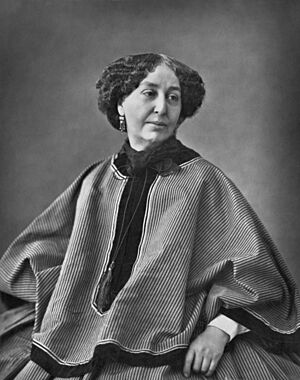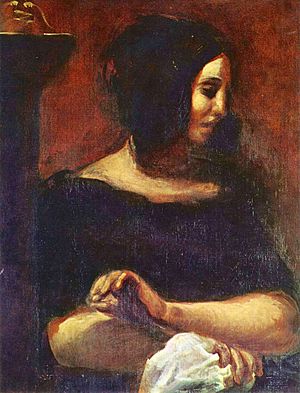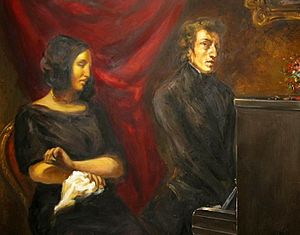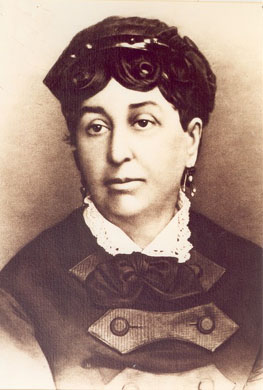George Sand facts for kids
Quick facts for kids
George Sand
|
|
|---|---|

Portrait by Nadar (1864)
|
|
| Born |
Amantine Lucile Aurore Dupin
1 July 1804 Paris, France
|
| Died | 8 June 1876 (aged 71) Nohant-Vic, Berry, France
|
| Occupation | Novelist |
| Movement | Pastoralism |
| Spouse(s) |
Casimir Dudevant
(m. 1822; separated 1835) |
| Children | Maurice Sand Solange Dudevant |
| Parents |
|
Amandine Aurore Lucile Dupin, later Baroness (French: baronne) Dudevant (born July 1, 1804 – died June 8, 1876), was a famous French writer. She is best known by her pen name, George Sand. She was also an early supporter of women's rights.
Contents
George Sand's Early Life

Amantine Lucile Aurore Dupin was born in Paris, France, on July 1, 1804. Her parents were Maurice Dupin de Francueil and Sophie-Victoire Delaborde. Her great-grandfather was the famous French Marshal, Maurice de Saxe. Aurore spent most of her childhood with her grandmother, Marie-Aurore de Saxe, at a house in the village of Nohant, France. When her grandmother passed away in 1821, Aurore inherited the house. This special place later became the setting for many of her stories.
In 1822, when she was 19, she married Baron Casimir Dudevant. They had two children, Maurice (born 1823) and Solange (born 1828). In 1831, she decided to leave her husband. In 1835, they officially separated.
George Sand's Public Image
George Sand started wearing men's clothes in public. This was very unusual for women at that time and caused people to talk about her. She said that men's clothes were stronger and cheaper than women's. They were also more comfortable. These clothes allowed her to move around Paris more freely than other women of her social class.
Sand also smoked in public, which was another shock to society. In her time, women, especially those from upper classes, were not expected to smoke. These actions were very different from the strict social rules of the 19th century.
George Sand's Relationships

George Sand had several important relationships throughout her life. These included friendships with writers like Jules Sandeau and Alfred de Musset. She also had a long relationship with the famous composer Frédéric Chopin from 1837 to 1847.
Later in her life, she became good friends with the writer Gustave Flaubert. They wrote many letters to each other, even though they had different personalities. She also had a close friendship with the actress Marie Dorval.
In Mallorca, an island in Spain, you can still visit an old monastery. George Sand spent the winter of 1838–39 there with Chopin and her children. She wrote about this trip in her book Un Hiver à Majorque (A Winter in Majorca).
Chopin and Sand ended their relationship two years before he died. This happened after a disagreement about her daughter Solange's marriage.
George Sand's Writing Career
George Sand began her writing journey with the writer Jules Sandeau. They wrote some stories together and signed them "Jules Sand." When she wrote her first independent novel, Indiana (1832), she chose the pen name George Sand, which became very famous.
Her first published novel, Rose et Blanche (1831), was written with Jules Sandeau.
She often wrote about the countryside, drawing from her own childhood experiences. Some of her well-known rural novels include La Mare au Diable (1846), François le Champi (1847–1848), and La Petite Fadette (1849). Her book A Winter in Mallorca described her time there with Chopin.
Other important novels she wrote are Indiana (1832), Lélia (1833), Mauprat (1837), and Consuelo (1842–1843).
She also wrote plays and autobiographical works, like Histoire de ma vie (History of my life) from 1855. She often performed her plays in a small private theater at her Nohant estate. George Sand also wrote literary reviews and political essays. One of her most famous quotes is: "There is only one happiness in life, to love and be loved."
Many famous people spoke about George Sand. The novelist Ivan Turgenev said, "What a brave man she was, and what a good woman." The poet Alfred de Musset called her "The most womanly woman."
George Sand's Death
George Sand died at her home in Nohant, France, on June 8, 1876. She was 71 years old. She was buried in the grounds of her home. In 2004, there were discussions about moving her remains to the Panthéon in Paris, a special building where many famous French people are buried.
George Sand in Popular Culture
George Sand's life and works have inspired many movies and TV shows:
- A Song to Remember (1945) is a movie about Chopin and George Sand.
- Notorious Woman (1974) was a TV miniseries about her life.
- The band Ambrosia recorded a song called "Danse With Me, George (Chopin's Plea)" in 1976.
- Impromptu (1991) is another movie about George Sand, starring Judy Davis.
- Les Enfants du siècle (1999) tells the story of her relationship with Alfred de Musset.
- Chopin (2002) is a Polish movie about Chopin, featuring George Sand.
- In 2007, Celine Dion recorded a song based on a love letter from George Sand.
- The band Meg & Dia have a song inspired by Sand's novel Indiana.
Interesting facts about George Sand
- George Sand was considered scandalous because of her adoption of masculine clothing and her masculine pseudonym.
- She criticized the institution of marriage and fought against the prejudices of a conservative society.
- By the age of 27, Sand was Europe's most popular writer.
- She was more popular than both Victor Hugo and Honoré de Balzac in England in the 1830s and 1840s, and she remained immensely popular as a writer throughout her lifetime and long after her death.
- When the 1848 Revolution began, she was a member of the provisional government of 1848 and the leaders of the day often consulted with her and took her advice.
- While many Republicans were imprisoned or went to exile after Louis-Napoléon Bonaparte's coup d'état of December 1851, she remained in France, maintained an ambiguous relationship with the new regime, and negotiated pardons and reduced sentences for her friends.
George Sand quotes
- "One is happy as a result of one's own efforts, once one knows the necessary ingredients of happiness — simple tastes, a certain degree of courage, self denial to a point, love of work, and, above all, a clear conscience."
- "Life resembles a novel more often than novels resemble life."
- "Masterpieces are only lucky attempts."
- "Art for the sake of art itself is an idle sentence. Art for the sake of truth, for the sake of what is beautiful and good — that is the creed I seek."
- "The truth is too simple: one must always get there by a complicated route."
- "Art is not a study of positive reality, it is the seeking for ideal truth."
Images for kids
-
Portrait of George Sand by Thomas Sully, 1826
-
Aurore Dupin meeting General Murat in her uniform, illustrated by H. J. Ford in 1913
-
Sand as Mary Magdalene in a sketch by Louis Boulanger
See also
 In Spanish: George Sand para niños
In Spanish: George Sand para niños







